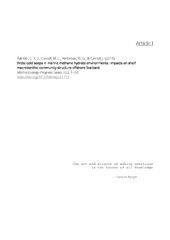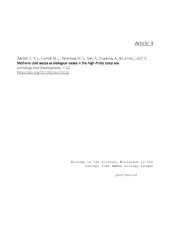| dc.contributor.advisor | Carroll, JoLynn | |
| dc.contributor.author | Åström, Emmelie | |
| dc.date.accessioned | 2018-05-28T08:05:58Z | |
| dc.date.available | 2018-05-28T08:05:58Z | |
| dc.date.issued | 2018-03-20 | |
| dc.description.abstract | Cold seeps are chemosynthetic habitats found in both deep sea and shallow ocean-shelves worldwide, including the polar regions. At seeps, hydrocarbons, sulfide, and other reduced compounds emerge from the seafloor, providing energy to fuel chemoautotrophic production. Microbial assemblages, supported by the oxidation and reduction of gases and fluids, form the base of a food web composing unique and specialized cold-seep ecosystems.
Several methane cold seeps have been documented in the high-Arctic, offshore Svalbard and in the Barents Sea, within the depth range of 85-1200 m. The widespread seabed gas seepage in these areas can be a strong environmental driver, influencing the local seafloor conditions and biosphere, including benthic community structure and ecosystem function.
The primary aim of this doctoral thesis has been to describe the current seep-associated communities and habitats located on the shelf of western Svalbard and in the Barents Sea. This included determining the ecological structure, diversity and food web interactions of macrofaunal assemblages at high-Arctic cold seeps, describing how they compare with conventional non-seep communities, and examining the interaction between seep and non-seep communities where they co-occur.
Key findings from the study are:
1) Cold seeps have a strong, localized effect over small spatial scales, supporting dense communities of small chemosymbiotic worms that play a fundamental role in structuring the seabed animal community
2) Cold seeps are identified as focal areas for the biosphere, providing heterogeneous substrates and additional food resources independent of photosynthetic sources from the surface ocean, resulting in animal aggregations at these habitats.
3) Methane-derived carbon is incorporated into the food web of the Barents Sea ecosystem.
4) The discovery of two new species of methane-associated bivalves at Svalbard cold seeps.
Cold seeps in the Arctic are of high ecological importance and methane is a key environmental driver of the biological system. Characteristic seep features, such as methane derived carbonate rocks and chemosymbiotic worm tufts, add complexity and 3D structure to the otherwise relatively flat and barren seafloor. Cold seeps provide shelter and substrate to both infauna and sessile organisms at seafloor, and to larger motile animals. Furthermore, cold seeps and seabed methane emissions add a supplementary energy source into the Arctic ecosystem. By combining results of analyses from different benthic habitats, this doctoral research project provides new insights into Arctic faunal community patterns at high-latitude cold seeps. | en_US |
| dc.description.doctoraltype | ph.d. | en_US |
| dc.description.popularabstract | Have you ever heard about cold seeps? They are referred to as the little brother of the underwater volcanoes or hot hydrothermal vents. Cold seeps are places where hydrocarbons, such as methane, are released from the seafloor. Like hydrothermal vents, cold seeps can support unique animal communities far beneath under the ocean’s surface and without access to sunlight. Most life on Earth is dependent on energy produced by the sun and photosynthesis. Cold seeps are chemosynthetic systems, meaning that the energy source for life here are chemical compounds rather than sunlight. Via microbial processes, energy can be generated from the seeping hydrocarbons.
Several methane cold seeps have been documented in the high Arctic, offshore Svalbard and in the Barents Sea. The widespread gas seepage in this area indicates that seabed emissions can be a strong environmental driver influencing the biosphere and local seafloor conditions, including ecosystem function and animal communities.
Off shore the shelves of Svalbard and in the Barents Sea, we investigated cold seeps within the depth range of 85-1200 m to describe the animal assemblages and surrounding habitats. The aim was to study the ecological structure, diversity and food web dynamics at high-Arctic cold seeps and document how they compared with conventional, non-seep communities and examining the interaction between seep and non-seep communities where they co-occur.
Key findings from the study are:
1) Cold seeps have a strong, localized effect over small areas, supporting dense communities of small chemosymbiotic worms that play an important role in structuring the seabed animal community
2) Cold seeps are identified as important areas, providing hard bottom surfaces, 3D-structure and food resources for bottom-living animals.
3) Methane-derived carbon is part of the food web of the Barents Sea ecosystem.
4) The discovery of two new species of methane-associated clams at Svalbard cold seeps.
This is the first dedicated study of high-Arctic cold seeps that focuses on the biological and ecological aspects of sea-floor communities offshore Svalbard.
Cold seeps in the Arctic are of high ecological importance and methane is a key environmental driver of the biological system. Characteristic seep features, such as methane derived carbonate rocks and chemosymbiotic worm tufts, add complexity and 3D-structure to the otherwise relatively flat and barren seafloor. Cold seeps provide shelter and substrate to both animals living in the sediment and at seafloor, and to larger and free-swimming animals. Furthermore, cold seeps and seabed methane emissions add a supplementary energy source into the Arctic ecosystem. | en_US |
| dc.description.sponsorship | Research Council of Norway funding scheme #223259 | en_US |
| dc.description | The paper III is not available in Munin.<br>
Paper III: Åström Hammenstig E. K. L., Carroll, M. L., Sen, A., Niemann, H., Ambrose, W. G., Lehman F.M., & Carroll, J.Trophic interactions and community structure at Barents Sea cold seeps. (Manuscript).<br>
Paper IV:
Åström, E. K. L., Oliver, P. G., & Carroll, M. L. (2017). A new Genus and two new Species of Thyasiridae Associated with Methane Seeps off Svalbard, Arctic Ocean. Available in <a href=https://doi.org/10.1080/17451000.2016.1272699> Marine Biology Research, 13(4), 402–416.</a>. Accepted manuscript version available in Munin at <a href=http://hdl.handle.net/10037/12794> http://hdl.handle.net/10037/12794 </a> | en_US |
| dc.identifier.isbn | 978-82-8236-290-0 (trykt) og 978-82-8236-291-7 (pdf) | |
| dc.identifier.uri | https://hdl.handle.net/10037/12795 | |
| dc.language.iso | eng | en_US |
| dc.publisher | UiT Norges arktiske universitet | en_US |
| dc.publisher | UiT The Arctic University of Norway | en_US |
| dc.relation.projectID | info:eu-repo/grantAgreement/RCN/SFF/223259/NORWAY/Centre for Arctic Gas Hydrate, Environment and Climate/CAGE/ | en_US |
| dc.rights.accessRights | openAccess | en_US |
| dc.rights.holder | Copyright 2018 The Author(s) | |
| dc.rights.uri | https://creativecommons.org/licenses/by-nc-sa/3.0 | en_US |
| dc.rights | Attribution-NonCommercial-ShareAlike 3.0 Unported (CC BY-NC-SA 3.0) | en_US |
| dc.subject | Arctic | en_US |
| dc.subject | Methane | en_US |
| dc.subject | Cold seeps | en_US |
| dc.subject | Chemosynthesis | en_US |
| dc.subject | Benthic communities | en_US |
| dc.subject | Svalbard | en_US |
| dc.subject | VDP::Mathematics and natural science: 400::Zoology and botany: 480::Marine biology: 497 | en_US |
| dc.subject | VDP::Matematikk og Naturvitenskap: 400::Zoologiske og botaniske fag: 480::Marinbiologi: 497 | en_US |
| dc.title | Benthic communities at high-Arctic cold seeps: Faunal response to methane seepage in Svalbard | en_US |
| dc.type | Doctoral thesis | en_US |
| dc.type | Doktorgradsavhandling | en_US |


 English
English norsk
norsk


